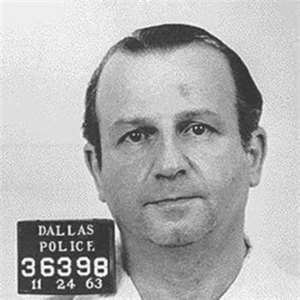Jack Ruby
| "“Lone nut”" (Assassin, JFK/Assassination/Premature death) | |
|---|---|
 | |
| Born | Jacob Leon Rubenstein 1911-03-25 Chicago, Illinois, United States |
| Died | January 3, 1967 (Age 55) Dallas |
Cause of death | Pulmonary embolism |
| Religion | Jewish |
Criminal charge | Murder of Lee Harvey Oswald |
| Parents | • Joseph Rubenstein • Fannie Turek Rutkowski |
| Victim of | premature death |
| Supposed perpetrator of | Lee Harvey Oswald/Assassination |
| Interest of | Seth Kantor |
| Subpage | •Jack Ruby/Death •Jack Ruby/Diagnosed with cancer •Jack Ruby/Wires money order |
A "lone nut" who killed another lone nut to try to hide the conspiracy which killed JFK. Both were actually assets controlled by the deep state groups who ran that coup. | |
Jack Leon Ruby (born Jacob Leon Rubenstein; March 25, 1911[1] – January 3, 1967) was a nightclub operator in Dallas, Texas. He shot and killed Lee Harvey Oswald, who was in police custody after being charged with the assassination of John F. Kennedy two days earlier.
“I tell you that a whole new form of government is going to take over the country and I know I won’t live to see you another time.”
Jack Ruby [2]
Accusations Of Conspiracy
Following Ruby's March 1964 conviction for murder with malice, Ruby's lawyers, led by Sam Houston Clinton, appealed to the Texas Court of Criminal Appeals, the highest criminal court in Texas. Ruby's lawyers argued that he could not have received a fair trial in Dallas because of the excessive publicity surrounding the case. A year after his conviction, in March 1965, Ruby conducted a brief televised news conference in which he stated: "Everything pertaining to what's happening has never come to the surface. The world will never know the true facts of what occurred, my motives. The people who had so much to gain, and had such an ulterior motive for putting me in the position I'm in, will never let the true facts come above board to the world." When asked by a reporter, "Are these people in very high positions, Jack?", he responded "Yes."
Dallas Deputy Sheriff Al Maddox claimed: "Ruby told me, he said, 'Well, they injected me for a cold.' He said it was cancer cells. That's what he told me, Ruby did. I said you don't believe that bullshit. He said, 'I damn sure do!' [Then] one day when I started to leave, Ruby shook hands with me and I could feel a piece of paper in his palm… [In this note] he said it was a conspiracy and he said... if you will keep your eyes open and your mouth shut, you're gonna learn a lot. And that was the last letter I ever got from him."[3] Not long before Ruby died, according to an article in the London Sunday Times, he told psychiatrist Werner Teuter that the assassination was "an act of overthrowing the government" and that he knew "who had President Kennedy killed." He added: "I am doomed. I do not want to die. But I am not insane. I was framed to kill Oswald."[3][4][5]
Until he died of a heart attack, aged 48, Tom Howard was the attorney for Jack Ruby.
Death
Eventually, the appellate court agreed with Ruby's lawyers for a new trial, and on October 5, 1966, ruled that his motion for a change of venue before the original trial court should have been granted. Ruby's conviction and death sentence were overturned. Arrangements were underway for a new trial to be held in February 1967 in Wichita Falls, Texas, when on December 9, 1966, Ruby was admitted to Parkland Hospital in Dallas, suffering from pneumonia. A day later, doctors realized he had cancer in his liver, lungs and brain. Three weeks later, he died.
References
- ↑ The Warren Commission found that various dates were given in the records for Ruby's birth; the one most used by Ruby himself was March 25, 1911 (The Warren Report: Report of the President's Commission on the Assassination of President John F. Kennedy, 1964). His tombstone at Westlawn Cemetery, Chicago has April 25, 1911 as his birthdate
- ↑ http://www.veteranstoday.com/2015/05/01/revisiting-history-did-jack-ruby-predict-the-america-of-today/ WhoWhatWhy
- ↑ a b Marrs, Jim (1989). Crossfire: The Plot that Killed Kennedy. New York: Carroll & Graf. pp. 431–432. ISBN 0-88184-648-1.Page Module:Citation/CS1/styles.css must have content model "Sanitized CSS" for TemplateStyles (current model is "Scribunto").
- ↑ The Sunday Times, August 25, 1974.
- ↑ Summers, Anthony. Not in Your Lifetime, (New York: Marlowe & Company, 1998), p. 341. ISBN 1-56924-739-0